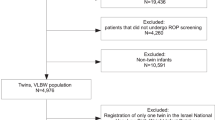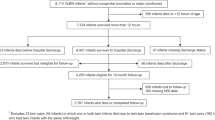Abstract
Background
Research in singletons identified fetal growth restriction (FGR) as a risk factor for retinopathy of prematurity (ROP), but is generally subject to confounding by genetic, obstetric, and maternal factors. We investigated the effect of FGR on ROP in growth-discordant identical twins, thereby controlling for confounding factors.
Methods
All data of monochorionic (MC) twin pairs with a birth weight discordance ≥20% born in our center between 2010 and 2021 were retrospectively reviewed for the presence of ROP. Potential risk factors for ROP were analyzed. Outcomes were compared between the smaller and larger twin.
Results
We included 88 MC twin pairs with growth discordance. In 34% (30/88), both neonates were at risk of ROP. Prevalence of ROP was higher among the smaller twin compared to the larger twin, 30% (9/30) versus 13% (4/30), respectively (OR 2.8, 95% CI: 1.2–6.6). The smaller twin had a longer duration of mechanical ventilation (8 (1–20) versus 2 (1–4) days) and received their first red blood cell transfusion at an earlier postmenstrual age (29.6 (28.1–31.6) versus 30.4 (29.7–32.6) weeks).
Conclusions
In this identical twin model, FGR is associated with almost tripled odds of ROP development, suggesting that both unfavorable antenatal growth conditions and adverse neonatal outcomes affect postnatal retinal vascular proliferation.
Impact
-
Fetal growth restriction in growth-discordant identical twins is associated with almost tripled odds of developing retinopathy of prematurity in the smaller twin.
-
Since these twins do not only differ in birth weight but also duration of mechanical ventilation and timing of the first red blood cell transfusion, both unfavorable antenatal growth conditions and adverse neonatal outcomes can affect postnatal retinal vascular proliferation.
-
More attention for preventing retinopathy of prematurity is needed in those with fetal growth restriction who received prolonged duration of mechanical ventilation, oxygen supplementation, or a first red blood cell transfusion <32 weeks postmenstrual age.
This is a preview of subscription content, access via your institution
Access options
Subscribe to this journal
Receive 14 print issues and online access
$259.00 per year
only $18.50 per issue
Buy this article
- Purchase on Springer Link
- Instant access to full article PDF
Prices may be subject to local taxes which are calculated during checkout

Similar content being viewed by others
Data availability
The dataset generated and analyzed during the current study is available from the corresponding author on reasonable request. The request will be reviewed by the research team and the ethics committee of the LUMC.
References
Hellström, A., Smith, L. E. & Dammann, O. Retinopathy of prematurity. Lancet 382, 1445–1457 (2013).
Sabri, K., Ells, A. L., Lee, E. Y., Dutta, S. & Vinekar, A. Retinopathy of prematurity: a global perspective and recent developments. Pediatrics 150, e2021053924 (2022).
Bashinsky, A. L. Retinopathy of prematurity. N. C. Med. J. 78, 124–128 (2017).
Dhaliwal, C. A., Fleck, B. W., Wright, E., Graham, C. & McIntosh, N. Retinopathy of prematurity in small-for-gestational age infants compared with those of appropriate size for gestational age. Arch. Dis. Child Fetal Neonatal Ed. 94, F193–F195 (2009).
Fortes Filho, J. B. et al. Is being small for gestational age a risk factor for retinopathy of prematurity? A study with 345 very low birth weight preterm infants. J. Pediatr. (Rio J.) 85, 48–54 (2009).
Razak, A. & Faden, M. Association of small for gestational age with retinopathy of prematurity: a systematic review and meta-analysis. Arch. Dis. Child Fetal Neonatal Ed. 105, 270–278 (2020).
Lewi, L. et al. The outcome of monochorionic diamniotic twin gestations in the era of invasive fetal therapy: a prospective cohort study. Am. J. Obstet. Gynecol. 199, 514.e1–e8 (2008).
Khalil, A. et al. Consensus definition and essential reporting parameters of selective fetal growth restriction in twin pregnancy: a Delphi procedure. Ultrasound Obstet. Gynecol. 53, 47–54 (2019).
Wang, X., Li, L., Yuan, P., Zhao, Y. & Wei, Y. Comparison of placental characteristics of twin-twin transfusion syndrome with and without selective intrauterine growth restriction. J. Matern. Fetal Neonatal Med. 35, 4306–4311. (2022).
Lopriore, E. et al. Neonatal morbidity in growth-discordant monochorionic twins: comparison between the larger and the smaller twin. Twin Res. Hum. Genet 15, 541–546 (2012).
Boghossian, N. S. et al. Birth weight discordance in very low birth weight twins: mortality, morbidity, and neurodevelopment. J. Perinatol. 39, 1229–1240. (2019).
Groene, S. G. et al. Respiratory distress syndrome and bronchopulmonary dysplasia after fetal growth restriction: lessons from a natural experiment in identical twins. EClinicalMedicine 32, 100725 (2021).
Zloto, O., Goldfinger Lerner, M., Mazkereth, R., Spierer, A. & Yinon, Y. Retinopathy of prematurity in discordant twins: is the small twin at increased risk? Graefes Arch. Clin. Exp. Ophthalmol. 258, 893–898 (2020).
Petricli, I. S., Kara, C., Isik, D. U., Demirel, N. & Bas, A. Y. Effect of birth weight on retinopathy of prematurity in discordant twin pairs. Indian J. Ophthalmol. 67, 806–810 (2019).
Woo, S. J. et al. A co-twin study of the relative effect of birth weight and gestational age on retinopathy of prematurity. Eye (Lond.) 25, 1478–1483 (2011).
Quintero, R. A. et al. Staging of twin-twin transfusion syndrome. J. Perinatol. 191, 550–555 (1999).
Benoit, R. M. & Baschat, A. A. Twin-to-twin transfusion syndrome: prenatal diagnosis and treatment. Am. J. Perinatol. 31, 583–594 (2014).
Khalil, A. et al. Consensus diagnostic criteria and monitoring of twin anemia-polycythemia sequence: Delphi procedure. Ultrasound Obstet. Gynecol. 56, 388–394. (2020).
Sueters, M. & Oepkes, D. Diagnosis of twin-to-twin transfusion syndrome, selective fetal growth restriction, twin anaemia-polycythaemia sequence, and twin reversed arterial perfusion sequence. Best. Pract. Res Clin. Obstet. Gynaecol. 28, 215–226 (2014).
Chmait, R. H. et al. Donor catch-up growth after laser surgery for twin-twin transfusion syndrome. Early Hum. Dev. 91, 751–754 (2015).
Groene, S. G. et al. Twin-twin transfusion syndrome with and without selective fetal growth restriction prior to fetoscopic laser surgery: short and long-term outcome. J. Clin. Med. 8, 969 (2019).
Gratacós, E. et al. A classification system for selective intrauterine growth restriction in monochorionic pregnancies according to umbilical artery Doppler flow in the smaller twin. Ultrasound Obstet. Gynecol. 30, 28–34 (2007).
Hoftiezer, L. et al. From population reference to national standard: new and improved birthweight charts. Am. J. Obstet. Gynecol. 220, 383.e1–e17 (2019).
van Sorge, A. J. et al. Reduction in screening for retinopathy of prematurity through risk factor adjusted inclusion criteria. Br. J. Ophthalmol. 97, 1143–1147 (2013).
International Committee for the Classification of Retinopathy of Prematurity. The International Classification of Retinopathy of Prematurity revisited. Arch. Ophthalmol. 123, 991–999 (2005).
Good, W. V. Final results of the Early Treatment for Retinopathy of Prematurity (ETROP) randomized trial. Trans. Am. Ophthalmol. Soc. 102, 233–248 (2004). discussion 48–50.
Bell, M. J. et al. Neonatal necrotizing enterocolitis. Therapeutic decisions based upon clinical staging. Ann. Surg. 187, 1–7 (1978).
Trzcionkowska, K. et al. Risk factors for retinopathy of prematurity in the netherlands: a comparison of two cohorts. Neonatology 118, 462–469 (2021).
Hellström, A. et al. New insights into the development of retinopathy of prematurity–importance of early weight gain. Acta Paediatr. 99, 502–508 (2010).
Kim, S. J. et al. Retinopathy of prematurity: a review of risk factors and their clinical significance. Surv. Ophthalmol. 63, 618–37. (2018).
Slidsborg, C. et al. Neonatal risk factors for treatment-demanding retinopathy of prematurity: a Danish national study. Ophthalmology 123, 796–803 (2016).
Stutchfield, C. J., Jain, A., Odd, D., Williams, C. & Markham, R. Foetal haemoglobin, blood transfusion, and retinopathy of prematurity in very preterm infants: a pilot prospective cohort study. Eye (Lond.) 31, 1451–1455 (2017).
Teofili, L. et al. Transfusion-free survival predicts severe retinopathy in preterm neonates. Front. Pediatr. 10, 814194 (2022).
Hengartner, T. et al. Associations between red blood cell and platelet transfusions and retinopathy of prematurity. Neonatology 117, 1–7 (2020).
Shukla, A. et al. Comparison of biphasic vs static oxygen saturation targets among infants with retinopathy of prematurity. JAMA Ophthalmol. 137, 417–423 (2019).
Author information
Authors and Affiliations
Contributions
All authors contributed to the conception and design of the study. J.A.S., E.L., and S.G.G. contributed to data acquisition and contributed to data analysis. All authors were involved with the data interpretation. J.A.S. contributed to the draft formation. S.E.E., N.E.S.-D., F.S., J.M.M.v.K., E.L., and S.G.G. revised it critically for important intellectual content. All authors approved with the final version.
Corresponding author
Ethics declarations
Competing interests
The authors declare no competing interests.
Ethics approval and consent to participate
The ethics committee of the LUMC waived the requirement for written informed consent (protocol number G20.004).
Additional information
Publisher’s note Springer Nature remains neutral with regard to jurisdictional claims in published maps and institutional affiliations.
Rights and permissions
Springer Nature or its licensor (e.g. a society or other partner) holds exclusive rights to this article under a publishing agreement with the author(s) or other rightsholder(s); author self-archiving of the accepted manuscript version of this article is solely governed by the terms of such publishing agreement and applicable law.
About this article
Cite this article
Spekman, J.A., El Emrani, S., Schalij-Delfos, N.E. et al. Association between fetal growth-restriction and retinopathy of prematurity using a unique identical twin model. Pediatr Res 94, 1738–1743 (2023). https://doi.org/10.1038/s41390-023-02670-7
Received:
Revised:
Accepted:
Published:
Issue Date:
DOI: https://doi.org/10.1038/s41390-023-02670-7



